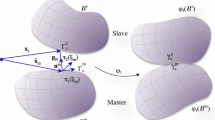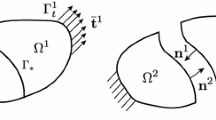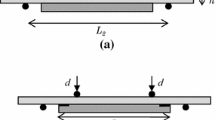Abstract
Cohesive zone (CZ) models have long been used by the scientific community to analyze the progressive damage of materials and interfaces. In these models, non-linear relationships between tractions and relative displacements are assumed, which dictate both the work of separation per unit fracture surface and the peak stress that has to be reached for the crack formation. This contribution deals with isogeometric CZ modeling of interface debonding. The interface is discretized with generalized contact elements which account for both contact and cohesive debonding within a unified framework. The formulation is suitable for non-matching discretizations of the interacting surfaces in presence of large deformations and large relative displacements. The isogeometric discretizations are based on non uniform rational B-splines as well as analysis-suitable T-splines enabling local refinement. Conventional Lagrange polynomial discretizations are also used for comparison purposes. Some numerical examples demonstrate that the proposed formulation based on isogeometric analysis is a computationally accurate and efficient technology to solve challenging interface debonding problems in 2D and 3D.















Similar content being viewed by others
References
Alfano G, Crisfield MA (2001) Finite element interface models for the delamination analysis of laminated composites: mechanical and computational issues. Int J Numer Methods Eng 50:1701–1736
Allix O, Ladevèze P (1992) Interlaminar interface modelling for the prediction of delamination. Compos Struct 22:235–242
Allix O, Ladevèze P, Corigliano A (1995) Damage analysis of interlaminar fracture specimens. Compos Struct 31(1):61–74
Allix O, Corigliano A (1999) Geometrical and interfacial non-linearities in the analysis of delamination in composites. Int J Solids Struct 36(15):2189–2216
ASTM Standard D3433–99 (2012) Standard test method for fracture strength in cleavage of adhesives in bonded metal joints. doi:10.1520/D3433-99R12. www.astm.org
Autodesk, Inc. (2011) http://www.tsplines.com/rhino/
Barenblatt GI (1959) The formation of equilibrium cracks during brittle fracture. General ideas and hypotheses. Axially-symmetric cracks. J Appl Math Mech 23:622–636
Bazilevs Y, Calo VM, Cottrell JA, Evans JA, Hughes TJR, Lipton S, Scott MA, Sederberg TW (2010) Isogeometric analysis using T-splines. Comput Methods Appl Mech Eng 199(5–8):229–263
Bolzon G, Corigliano A (1997) A discrete formulation for elastic solids with damaging interfaces. Comput Methods Appl Mech Eng 140:329–359
Borden MJ, Scott MA, Evans JA, Hughes TJR (2011) Isogeometric finite element data structures based on Bézier extraction of NURBS. Int J Numer Methods Eng 87:15–47
Corigliano A (1993) Formulation, identication and use of interface models in the numerical analysis of composite delamination. Int J Solids Struct 30(20):2779–2811
Cottrell JA, Hughes TJR, Bazilevs Y (2009) Isogeometric analysis: toward Integration of CAD and FEA. Wiley, New York
Crisfield MA, Alfano G (2002) Adaptive hierarchical enrichment for delamination fracture using a decohesive zone model. Int J Numer Methods Eng 54:1369–1390
De Lorenzis L, Zavarise G (2009) Cohesive zone modeling of interfacial stresses in plated beams. Int J Solids Struct 46(24):4181–4191
De Lorenzis L, Zavarise G (2009) Interfacial stress analysis and prediction of debonding for a thin plate bonded to a curved substrate. Int J Non-Linear Mech 44(4):358–370
De Lorenzis L, Temizer İ, Wriggers P, Zavarise G (2011) A large deformation frictional contact formulation using NURBS-based isogeometric analysis. Int J Numer Methods Eng 87(13):1278–1300
De Lorenzis L, Wriggers P, Zavarise G (2012) A mortar formulation for 3D large deformation contact using NURBS-based isogeometric analysis and the augmented Lagrangian method. Comput Mech 49(1):1–20
Deng J, Chen F, Li X, Hu C, Tong W, Yang Z, Feng Y (2008) Polynomial splines over hierarchical T-meshes. Graph Models 70:76–86
Dimitri R, De Lorenzis L, Scott MA, Wriggers P, Taylor RL, Zavarise G (2014) Isogeometric large deformation frictionless contact using T-splines. Comput Methods Appl Mech Eng 269:394–414
Dokken T, Lyche T, Pettersen KF (2013) Polynomial splines over locally refined box-partitions. Comput Aided Geom Des 30(3):331–356
Dörfel MR, Jüttler B, Simeon B (2010) Adaptive isogeometric analysis by local h-refinement with T-splines. Comput Methods Appl Mech Eng 199:264–275
Dugdale DS (1960) Yielding of steel sheets containing slits. J Mech Phys Solids 8:100–104
Fischer KA, Wriggers P (2005) Frictionless 2D contact formulations for finite deformations based on the mortar method. Comput Mech 36:226–244
Guimatsia I, Ankersen JK, Davies GAO, Iannucci L (2009) Decohesion finite element with enriched basis functions for delamination. Compos Sci Technol 69(15–16):2616–2624
Hermes FH (2010) Process zone and cohesive element size in numerical simulations of delamination in bi-layers. MT 10.21, Eindhoven, September 24th, 2010
Hughes TJR (1987) The finite element method. Linear static and dynamic finite element analysis. Prentice-hall, Englewood Cliffs
Hughes TJR, Cottrell JA, Bazilevs Y (2005) Isogeometric analysis: CAD, finite elements, NURBS, exact geometry and mesh refinement. Comput Methods Appl Mech Eng 194:4135–4195
Kiendl J, Bletzinger KU, Linhard J, Wüchner R (2009) Isogeometric shell analysis with Kirchhoff-Love elements. Comput Methods Appl Mech Eng 198(49–52):3902–3914
Laursen TA (2002) Computational contact and impact mechanics. Springer, Berlin
Lu J (2011) Isogeometric contact analysis: geometric basis and formulation for frictionless contact. Comput Methods Appl Mech Eng 200:726–740
Matzen ME, Cichosz T, Bischoff M (2013) A point to segment contact formulation for isogeometric, NURBS based finite elements. Comput Methods Appl Mech Eng 255:27–39
Needleman A (1987) A continuum model for void nucleation by inclusion debonding. J Appl Mech 54:525–531
Needleman A (1990) An analysis of tensile decohesion along an interface. J Mech Phys Solids 38(3):289–324
Nguyen-Thanh N, Nguyen-Xuan H, Bordas SP, Rabczuk T (2011) Isogeometric analysis using polynomial splines over hierarchical T-meshes for two-dimensional elastic solids. Comput Methods Appl Mech Eng 200(21–22):1892–1908
Nguyen VP, Nguyen-Xuan H (2013) High-order B-splines based finite elements for delamination analysis of laminated composites. Compos Struct 102:261–275
Papadopoulos P, Jones RE, Solberg JM (1995) A novel finite element formulation for frictionless contact problems. Int J Numer Methods Eng 38:2603–2617
Point N, Sacco E (1996) A delamination model for laminated composites. Int J Solids Struct 33(4):483–509
Raju IS (1987) Calculation of strain-energy release rates with higher order and singular finite elements. Eng Fract Mech 28:251–274
Sauer R (2011) Enriched contact finite elements for stable peeling computations. Int J Numer Methods Eng 87:593–616
Sauer RA, De Lorenzis L (2013) A computational contact formulation based on surface potentials. Comput Methods Appl Mech Eng 253:369–395
Samini M, van Dommelen JAW, Geers MGD (2009) An enriched cohesive zone model for delamination in brittle interfaces. Numer Methods Eng 80(5):609–630
Samini M, van Dommelen JAW, Geers MGD (2011) A self-adaptive finite element approach for simulation of mixed-mode delamination using cohesive zone models. Eng Fract Mech 78(10):2202–2219
Schellekens JCJ, de Borst R (1993) A non-linear finite element approach for the analysis of mode-I free edge delamination in composites. Int J Solids Struct 30:1239–1253
Schillinger D, Ruess M, Zander N, Bazilevs Y, Düster A, Rank E (2012) Small and large deformation analysis with the p- and B-spline versions of the finite cell method. Comput Mech 50:445–478
Scott MA, Borden MJ, Verhoosel CV, Sederberg TW, Hughes TJR (2011) Isogeometric finite element data structures based on Bézier extraction of T-splines. Numer Methods Eng 88(2):126–156
Scott MA, Li X, Sederberg TW, Hughes TJR (2012) Local refinement of analysis-suitable T-splines. Comput Methods Appl Mech Eng 213–216:206–222
Sederberg TW, Zheng J, Bakenov A, Nasri A (2003) T-splines and T-NURCCSs. ACM Trans Graph 22(3):477–484
Sederberg TW, Zheng J, Song X (2003) Knot intervals and multi-degree splines. Comput Aided Geom Des 20:455–468
Sederberg TW, Cardon DL, Finnigan GT, North NS, Zheng J, Lyche T (2004) T-spline simplification and local refinement. ACM Trans Graph 23(3):276–283
Sederberg TW, Finnigan GT, Lin X, Ipson H (2008) Watertight trimmed NURBS, ACM Transactions on Graphics (TOG)—Proceedings of ACM SIGGRAPH, 27(3), Article No. 79, 2008
Taylor RL (2013) FEAP—finite element analysis program. University of California, Berkeley. http://www.ce.berkeley.edu/projects/feap/
Temizer İ, Wriggers P, Hughes TJR (2011) Contact treatment in isogeometric analysis with NURBS. Comput Methods Appl Mech Eng 200(9–12):1100–1112
Temizer İ, Wriggers P, Hughes TJR (2012) Three-dimensional mortar-based frictional contact treatment in isogeometric analysis with NURBS. Comput Methods Appl Mech Eng 209–212:115–128
Tvergaard V, Hutchinson JW (1992) The relation between crack growth resistance and fracture process parameters in elastic-plastic solids. J Mech Phys Solids 40(6):1377–1397
Tvergaard V, Hutchinson JW (1993) The influence of plasticity on mixed mode interface toughness. J Mech Phys Solids 41(6):1119–1135
Verhoosel CV, Scott MA, de Borst R, Hughes TJR (2011) An isogeometric approach to cohesive zone modeling. Int J Numer Meth Eng 87(1–5):336–360
Vuong AV, Giannelli C, Jüttler B, Simeon B (2011) A hierarchical approach to adaptive local refinement in isogeometric analysis. Comput Methods Appl Mech Eng 49–52:3554–3567
Wang W, Zhang Y, Scott MA, Hughes TJR (2011) Converting an unstructured quadrilateral mesh to a standard T-spline surface. Comput Mech 48(4):477–498
Wei Y, Hutchinson JW (1998) Interface strength, work of adhesion and plasticity in the peel test. Int J Fract 93:315–333
Wriggers P (2006) Computational contact mechanics, 2nd edn. Spinger, Berlin
Zhang Y, Wang W, Hughes TJR (2012) Solid T-spline construction from boundary representations for genus-zero geometry. Comput Methods Appl Mech Eng 249–252:185–197
Acknowledgments
The authors at the Università del Salento and at the Technische Universität Braunschweig have received funding for this research from the European Research Council under the European Union’s Seventh Framework Programme (FP7/2007-2013), ERC Starting Researcher Grant “INTERFACES”, Grant Agreement No. 279439.
Author information
Authors and Affiliations
Corresponding author
Rights and permissions
About this article
Cite this article
Dimitri, R., De Lorenzis, L., Wriggers, P. et al. NURBS- and T-spline-based isogeometric cohesive zone modeling of interface debonding. Comput Mech 54, 369–388 (2014). https://doi.org/10.1007/s00466-014-0991-7
Received:
Accepted:
Published:
Issue Date:
DOI: https://doi.org/10.1007/s00466-014-0991-7




